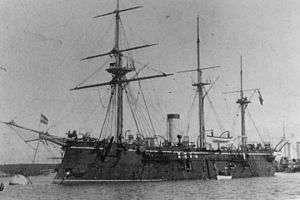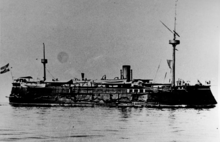Kaiser Max-class ironclad (1875)
 Kaiser Max c. 1880–89 | |
| Class overview | |
|---|---|
| Operators: |
|
| Preceded by: | SMS Erzherzog Albrecht |
| Succeeded by: | SMS Tegetthoff |
| Built: | 1874–1878 |
| In commission: | 1876–1912 |
| Completed: | 3 |
| Lost: | 1 |
| Retired: | 2 |
| General characteristics | |
| Class and type: | Casemate ship |
| Displacement: | 3,548 metric tons (3,492 long tons; 3,911 short tons) |
| Length: | |
| Beam: | 15.25 m (50 ft 0 in) |
| Draft: | 6.15 m (20 ft 2 in) |
| Installed power: | 2,755 ihp (2,054 kW) |
| Propulsion: |
|
| Speed: | 13.28 knots (24.59 km/h; 15.28 mph) |
| Crew: | 400 |
| Armament: |
|
| Armor: | |
The Kaiser Max class of ironclad warships was a group of three casemate ships built for the Austro-Hungarian Navy in the 1870s: Kaiser Max, Don Juan d'Austria, and Prinz Eugen. The three ships were ostensibly the same vessels as the earlier Kaiser Max class, though they were in fact entire new vessels. Only parts of the earlier ships' machinery, armor plating, and other equipment were reused in the new ironclads. The ships were all laid down in 1874; the first two were launched in 1875 and completed in 1876, while work on Prinz Eugen proceeded much more slowly. She was launched in 1877 and completed in 1878. The three ships were armed with a battery of eight 21-centimeter (8.3 in) guns mounted in a central, armored casemate, and were capable of a top speed of 13.28 knots (24.59 km/h; 15.28 mph).
The ships had fairly uneventful careers, owing in part to the restricted naval budgets of the 1870s and 1880s, which precluded an active fleet policy. The three ships made one major overseas cruise to Spain in 1888 to take part in the Barcelona Universal Exposition. They were withdrawn from service in the early 1900s and converted for secondary roles; Kaiser Max and Don Juan d'Austria became barracks ships and Prinz Eugen became a repair ship and was renamed Vulkan. After World War I, Don Juan d'Austria sank under unclear circumstances while the other two ships were seized by Italy. Kaiser Max was transferred to the Royal Yugoslav Navy in the postwar peace negotiations and renamed Tivat. Italy refused to turn Vulkan over to Yugoslavia, however. The ultimate fate of both vessels is unclear.
Design
In the early 1870s, the head of the Austro-Hungarian Navy, Friedrich von Pöck, repeatedly tried to secure funding from parliament for new ironclad warships, but the government, preoccupied with rebuilding the Austro-Hungarian Army after its crushing defeat at the Battle of Königgrätz in 1866, refused to divert funds to the navy's budget for new ships.[1] Reconstruction projects were uncontroversial, however, and so Pöck requested funds to rebuild the old Kaiser Max-class ironclads, intending instead to use the money to build new ships. The new vessels would be built to similar dimensions as the earlier vessels, and some material, including the engines, armor plate, and various fittings, would be reused to save money. To complete the deception, he assigned the ships the same names, which has led to some confusion in subsequent histories.[2][3] Part of the confusion owes to the records in the Austrian state and military archives, which refer to the ships as simple conversions, not new constructions.[4] The design for the new ships was prepared by Chief Engineer Josef von Romako, who had also designed the earlier Kaiser Maxes. The "reconstructions" proved to be very economical, with the three new ships costing as much as had been spent on the ironclad Erzherzog Albrecht.[5]
General characteristics and machinery
The ships of the Kaiser Max class were 75.87 meters (248 ft 11 in) long overall and 73.23 m (240 ft 3 in) long at the waterline. They had a beam of 15.25 m (50 ft 0 in) and an average draft of 6.15 m (20 ft 2 in). The ships displaced 3,548 metric tons (3,492 long tons; 3,911 short tons). Each vessel had a crew that ranged from 400 to 440 officers and enlisted men.[3][6]
Their propulsion system consisted of one horizontal, single-expansion, 2-cylinder steam engine that had been salvaged from the earlier Kaiser Maxes. The engine drove a single screw propeller that was 5.64 m (18.5 ft) in diameter. Steam was provided by five coal-fired boilers with thirty fireboxes, which were trunked into a single funnel. The engines produced a top speed of 13.28 knots (24.59 km/h; 15.28 mph) from 2,755 indicated horsepower (2,054 kW).[3][6] Each ship had a storage capacity of 380 metric tons (370 long tons; 420 short tons) of coal.[5] The ships were originally fitted with a barquentine rig with an area of 1,633.15 square meters (17,579.1 sq ft), but in 1880 the rigging was cut down to 1,156.6 m2 (12,450 sq ft).[3]
Armament and armor
The Kaiser Max-class ships were casemate ships, which concentrated the main battery in a centrally-located armored casemate, which allowed for limited end-on fire, though only forward, unlike earlier ironclads. Their battery of eight 21-centimeter (8.3 in) 20-caliber (cal.) guns manufactured by Krupp were mounted four on each broadside, with the forwardmost guns on each side in an angled gun port. They also carried four 9 cm (3.5 in) 24-cal. guns, two 7 cm (2.8 in) 15-cal. landing guns, six 47 mm (1.9 in) 35-cal. quick-firing guns, three 47 mm (1.9 in) Hotchkiss revolver cannon, and two 25 mm (0.98 in) guns. Each ship of the Kaiser Max class also had four 35 cm (14 in) torpedo tubes, one in the bow, one in the stern, and one on each broadside.[3]
The ships' armor protection consisted of an armored belt that was 203 mm (8 in) thick and was capped with 115 mm (4.5 in) thick transverse bulkheads on either end of the citadel. Only the two strakes of the belt armor were newly manufactured; the rest of the iron used to protect the casemate deck came from the earlier Kaiser Max class. The casemate battery was protected with 125 mm (4.9 in) thick plates.[3] The new belt armor consisted of Bessemer steel.[7]
Ships
| Name | Builder[3] | Laid down[3] | Launched[3] | Completed[3] |
|---|---|---|---|---|
| Kaiser Max | Stabilimento Tecnico Triestino, Trieste | 14 February 1874 | 28 December 1875 | 26 October 1876 |
| Don Juan d'Austria | 14 February 1874 | 25 October 1875 | 26 June 1876 | |
| Prinz Eugen | Pola Naval Arsenal, Pola | October 1874 | 7 September 1877 | November 1878 |
Service history

The three ships spent the 1870s laid up in Pola; budgetary issues prevented the ironclad fleet from being active.[8] In 1881, Prinz Eugen was mobilized for the first time to take part in an international naval demonstration against the Ottoman Empire to force it to transfer the city of Ulcinj to Montenegro in accordance with the terms of the 1878 Congress of Berlin.[9] In 1888, all three ships travelled to Barcelona, Spain, with several other major warships to take part in the opening ceremonies for the Barcelona Universal Exposition. This was the largest squadron of the Austro-Hungarian Navy that had operated outside the Adriatic up to that point.[10] The three ships participated in fleet training exercises in June and July 1889.[11]
The three Kaiser Maxes were stricken from the naval register after the turn of the century to free up funds for new construction projects.[12] Kaiser Max and Don Juan d'Austria were deleted from the list in December and June 1904, respectively, though Prinz Eugen lingered on until December 1912. The first two ships became floating barracks and Prinz Eugen was converted into a repair ship and renamed Vulkan. All three members of the class remained in the navy's inventory through World War I; Italy seized Kaiser Max and Vulkan, though both were awarded to the Royal Yugoslav Navy in the postwar peace negotiations. Italy refused to relinquish Vulkan, the fate of which is unknown, but Kaiser Max was transferred to Yugoslavia and renamed Tivat.[3] The ship was either scrapped in 1924,[13] or kept in the Yugoslav inventory until the country was overrun in the Axis invasion during World War II, her fate after falling back into Italian hands unknown. Don Juan d'Austria, meanwhile, sank under uncertain circumstances in 1919 before she could be seized by the victorious Allied powers.[3]
Notes
References
- Brassey, Thomas A. (1882). The British Navy: Its Strength, Resources, and Administration. London: Longman's, Greene & Co. OCLC 3468037.
- "Foreign Items". The United States Army and Navy Journal and Gazette of the Regular and Volunteer Forces. New York: Army and Navy Journal, Inc. 24: 913. 1889. OCLC 1589766.
- Gardiner, Robert, ed. (1979). Conway's All the World's Fighting Ships: 1860–1905. London: Conway Maritime Press. ISBN 0-85177-133-5.
- Pawlik, Georg (2003). Des Kaisers Schwimmende Festungen: die Kasemattschiffe Österreich-Ungarns [The Kaiser's Floating Fortresses: The Casemate Ships of Austria-Hungary]. Vienna: Neuer Wissenschaftlicher Verlag. ISBN 978-3-7083-0045-0.
- Sondhaus, Lawrence (1994). The Naval Policy of Austria-Hungary, 1867–1918. West Lafayette: Purdue University Press. ISBN 978-1-55753-034-9.
- Vego, Milan (1982). "The Yugoslav Navy 1918–1941". Warship International. Toledo: International Naval Research Organisation (4): 342–361. ISSN 0043-0374.